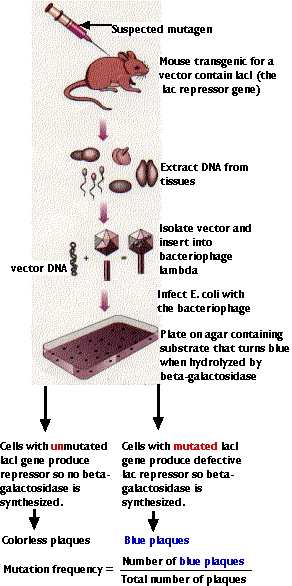Using Mice to Test for Chemical Mutagens

Salmonella typhimurium, the organism used in the Ames test, is a bacterium and thus is not a perfect model of the human body (which is why liver enzymes are added to the test). In fact, some suspected human carcinogens are negative in the Ames test.
Rapid in vitro tests modeled on the Ames test have been adapted for some eukaryotic cells such as - yeast and
- mammalian cells grown in vitro.
But what is needed is a way to combine the speed of in vitro tests like the Ames test with the more realistic conditions in whole animals.
Thanks to recombinant DNA technology (and the efforts of Stratagene, a biotechnology company), such a test is now available.
The test animal is a transgenic mouse which the company calls Big Blue.
Big Blue mice are transgenic for a segment of DNA that contains:
- the DNA of bacteriophage lambda, a virus that infects E. coli, and which serves here as the vector for
- 3 genetic elements from the lac operon of E. coli
The transgenic mice are given repeated doses of the suspected carcinogen for a week or two.
If the chemical is mutagenic, it will cause random mutations throughout the genome of each mouse cell. If a mutation occurs in either
- the lacI gene (which encodes the lac repressor) or
- the operator,
the gene (lacZ) for beta-galactosidase will no longer be repressed.
To detect this,
- The DNA is extracted from the tissues of the treated mouse.
- The vector is isolated and used to make functional bacteriophages.
- E. coli cells are mixed with the bacteriophage and spread on a solid culture medium.
- The bacteriophages infect and destroy ("lyze") the E. coli cells.
- This causes clear circular zones, called plaques, to appear in a "lawn" of bacteria.
- Before they die, cells that have been infected by bacteriophages carrying a mutated lacI or operator will produce beta-galactosidase.

- This reacts with a substrate in the culture medium turning it blue.
- Bacteriophages with unmutated genes produce colorless plaques because no beta-galactosidase is synthesized.
- Count both colorless and blue plaques.
- The number of blue plaques divided by the total number of plaques gives the mutation frequency.
The graph shows the results of a test done on the spleen cells of a transgenic mouse that had been dosed with benzopyrene, a known mutagen (and carcinogen). Three days after its last dose, 46 blue plaques were recovered from the spleen sample out of a total of 2,647,040 plaques. This yields a mutation frequency of 1.7 x 10−5 (1.7 in 100,000) — a significant increase over control values.

This photograph (courtesy of Stratagene) shows one mutant (blue) plaque on a lawn of E. coli containing many non-mutant (clear) plaques.
22 October 2022



